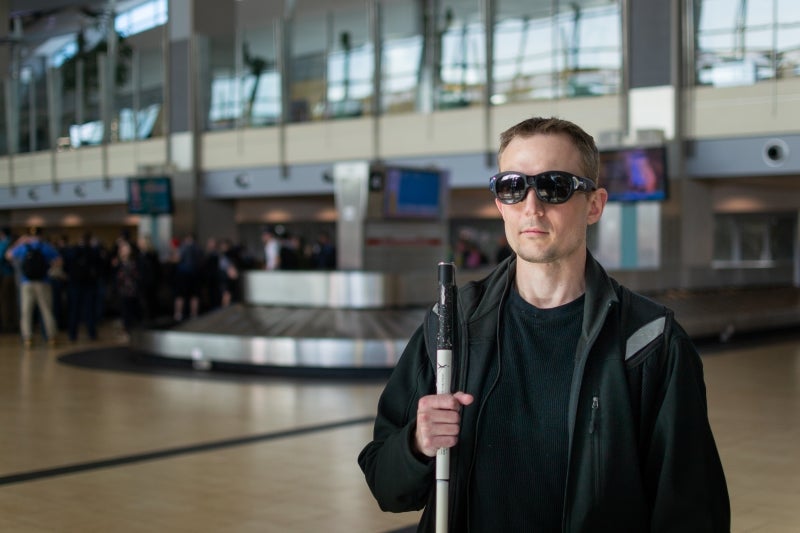
For a person living with blindness or visual impairment, stepping into an unfamiliar area without assistance is a great leap into the unknown, a landscape full of hidden dangers and time-consuming complications.
In a world designed to be navigated primarily by sight, there are precious few accommodations made for those living without the vision that most of us take for granted.
Where such concessions do exist, they are often remarkable in their ingenuity and value.
In many towns and cities, busy pavements are pock-marked with bumps and stripes that blind people can feel under their feet, a tactile language informing visually impaired walkers about safe road crossings and potential hazards.
Unlike local streets, to which blind people can gradually acclimatise themselves, airports are incredibly complex spaces that the average traveller doesn’t pass through often enough to learn their winding routes by heart.
For vision-impaired people who want to experience the freedom of international travel, the sprawling and noisy airport environment often presents the most intimidating obstacle in their path.
It’s an issue that the commercial aviation industry acknowledges, as Brisbane Airport recently showed when it partnered with non-profit Vision Australia to run ‘Travel Days’ to help people with vision loss familiarise themselves with the ins and outs of the airport’s domestic and international terminals.
For day-to-day assistance, the majority of airports offer support to blind and visually impaired passengers through guides who are assigned to escort travellers from check-in desk to gate when requests are made through airlines, or by allowing passengers to board flights with their own guide dogs.
Human guides provide a vital service for those who need it, but it’s not a perfect solution.
Being led by a member of staff, or pushed in wheelchairs that are mandatory in some cases, can be awkward for blind passengers looking to maintain as much independence as possible, or for those who, for personal or cultural reasons, are uncomfortable about physical contact with a stranger.
The latter issue inspired blind Glasgow resident Tom Forsyth and his neighbour Laura Maclean to invent the Ramble Tag, an arm harness with a handle on the outside that allows a user to be guided without bodily contact. The device is now being used at Glasgow Airport.
‘Sight on demand’
As digital technologies continue to evolve, new solutions are emerging to provide next-generation guidance for blind people, often powered by nothing more than a smartphone app and an internet connection.
IBM, for example, is piloting NavCog, a voice-controlled smartphone app for navigating indoor environments using Bluetooth beacons, and is currently working on an ‘AI suitcase’ that could provide guidance as well as flight information for users moving through an airport.
But there is one assistive technology that has proven particularly popular with airports in the last couple of years: it’s called Aira, a system that gets its name from the combination of artificial intelligence and remote assistance.
Developed by a San Diego-based company of the same name, Aira has been touted as ‘sight on demand’ for its users.
The Aira system works through a smartphone app and an optional pair of smart glasses, allowing users to connect through a tap or a voice command with a remote agent, who can then act as a second pair of eyes, providing real-time guidance and information.
Aira’s smart glasses also come pre-loaded with an AI agent called Chloe, which can assist with basic tasks such as reading.
Aira is designed to assist with everyday tasks ranging from grocery shopping to picking an outfit in the morning, but its functions have found a particularly enticing niche in airports.
The Aira Access scheme provides free use of the app in certain locations, and a growing number of airports are signing up.
Early airport adopters of the technology include Houston Airports, Memphis International Airport and Seattle-Tacoma.
In December last year, London’s Heathrow Airport became the biggest air hub to join the Aira network, bringing the technology to the 6,000 visually impaired passengers who travel through the airport each year.
Soon after, Aira announced that five new airports had joined the Aira Access scheme, including Wellington Airport in New Zealand, and US airports located in San Diego, Columbus, Milwaukee and Tucson.
Digital innovations like Aira have the potential to transform the daily lives of millions of people with vision loss around the world, especially in chaotic environments like airports, which present a daunting prospect for all but the most experienced travellers.
Aira has clearly secured the early mover advantage in this space, but more competition would almost certainly accelerate the pace of innovation.
Now that Aira has shown the potential for technology to connect users to the guidance and information they need, there’s never been a better time for visually impaired travellers to explore the world without fear.
Click here to listen to the special audio version of this article.



